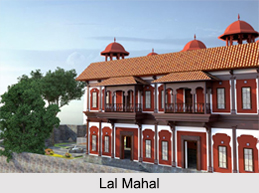 Lal Mahal also known as Red Palace is located in Pune, which was once the centre of Maratha Power. In the year 1630 AD, the great Maratha Emperor Shivaji`s father Shahaji Bhosle established Lal Mahal for his wife Jijabai and son. Shivaji stayed here for several years until he captured his first fort. Lal Mahal fell into ruins and the current Lal Mahal is a reconstruction of the age old Lal Mahal.
Lal Mahal also known as Red Palace is located in Pune, which was once the centre of Maratha Power. In the year 1630 AD, the great Maratha Emperor Shivaji`s father Shahaji Bhosle established Lal Mahal for his wife Jijabai and son. Shivaji stayed here for several years until he captured his first fort. Lal Mahal fell into ruins and the current Lal Mahal is a reconstruction of the age old Lal Mahal.
Historical significance of Lal Mahal
Historically, the Lal Mahal is famous for an encounter between Shivaji and the Mughal General Shaista Khan where Shivaji cut off the fingers of Shaista Khan when he was trying to escape from the window of the Lal Mahal. This was part of a surreptitious guerrilla attack on the massive and entrenched Mughal Army that had camped in Pune, with Shaista Khan occupying Shivaji`s childhood home. As a punishment for the ignominy of the defeat despite superior numbers and better armed and fed soldiers, Shaista Khan was transferred by the Mughal Emperor to Bengal.
Events at Lal Mahal
The wedding of Shivaji with his first wife, Maharani Saibai took place in Lal Mahal. Lal Mahal was built with the idea of rejuvenating the recently razed city of Pune when Dadoji Kondev entered the city along with Shivaji and his mother, Jijabai. Shivaji grew up here, and stayed in the Lal Mahal till he captured the Torna fort in the year 1645.
Location of Lal Mahal
The official records shows that Lal Mahal was used for arranging feasts for the Brahmins during the thread-ceremony of Sadoba, son of Chimajiappa. The exact original location of the Lal Mahal is unknown; however it was known to be very close to the location of Shaniwarwada, which is roughly where the current reconstruction of Lal Mahal stands.
Lal Mahal, which is now located was built only on a part of the land of the original Lal Mahal. The new Lal Mahal was not rebuilt in the same fashion as the original one. The current Lal Mahal was rebuilt by the PMC. The construction of Lal Mahal started in 1984 and was completed in 1988.
Decline of Lal Mahal
Towards the end of the 17th century, the Lal Mahal fell into ruins and was eventually razed to the ground as a result of various attacks on the city by the Mughals and later the British. It is said that during the construction of the Shaniwarwada, some soil and stones of the Lal Mahal were used for luck. In 1734-35, a few houses were constructed on the land of the Lal Mahal and given for use to Ranoji Shinde and Ramchandraji.
Memoirs of Lal Mahal
Lal Mahal is an architectural memorial that is holding a collection of large size oil-paintings based on the significant events in the life of Shivaji, a statue of Rajmata Jijabai. The carving is depicting Shivaji, the Maratha Hero using a gold plough along with Dadoji Konddeo and Jijabai. There is a fibre model of Raigad with horsemen and a huge map of Maharashtra indicating the forts of Shivaji. Jijamata Garden near Lal Mahal is now a recreational park.



















